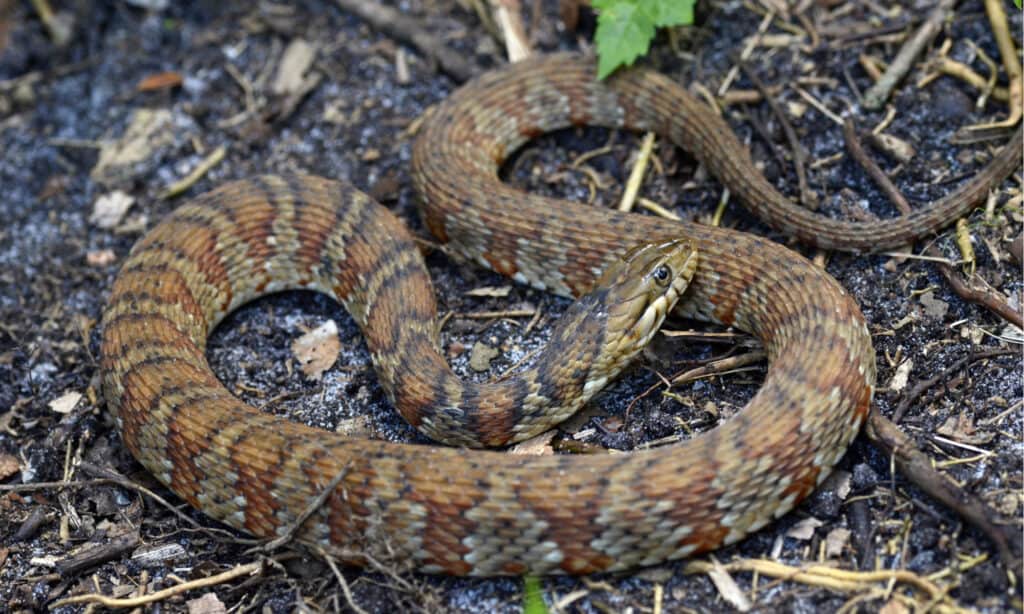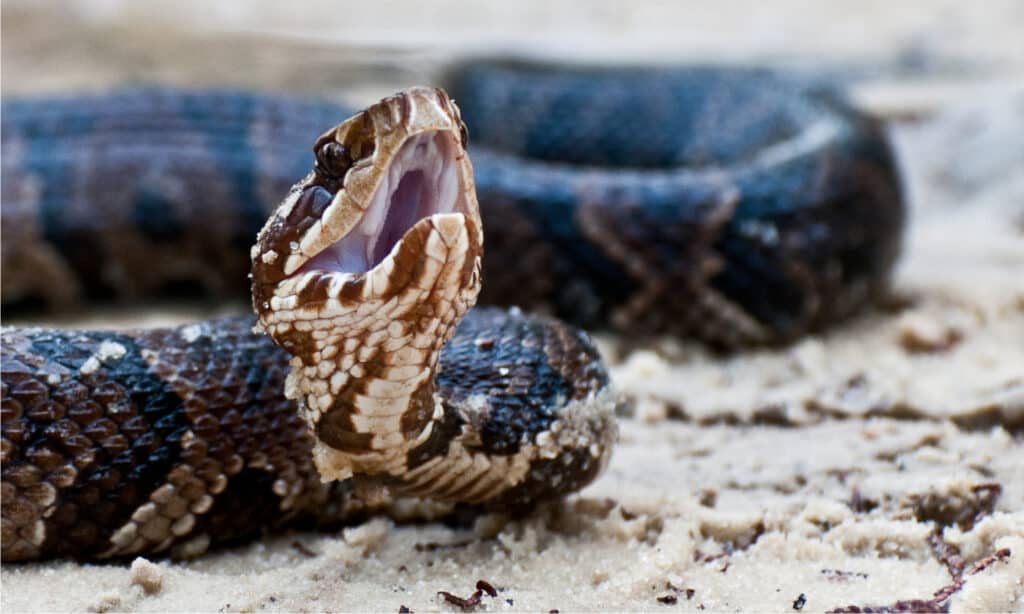Snakes come in a variety of shapes and colors. One possible coloration is a brown snake with black stripes. You may have seen a snake that looks like this but didn’t know what it was.
This complete guide will walk you through the most common brown snake with black stripes, helping you to prepare to identify one in the future. Ready to learn more? Let’s get started!
What Is a Brown Snake With Black Stripes?
You may come across many different brown snakes with black markings. However, finding a brown snake with clear black stripes can be a little more difficult. This is because many times, while it may look like a snake has black stripes, these markings are actually spots or blotches and not a uniform design. As a result, while they may appear to have stripes in some areas, in other areas, it’s clearer that the snake has a different pattern.
One of the most common brown snakes with black stripes is the banded water snake.
About the Banded Water Snake
The banded water snake (Nerodia fasciata) is also known as the southern water snake. There are three different subspecies of banded water snake, including the following:
- Broad-banded water snake (N. f. confluens)
- Florida banded water snake (N. f. pictiventris)
- Originally described as a banded water snake (N. f. fasciata)
Overall, banded water snakes are a fairly secretive species. They won’t choose to attack as the first course of action when threatened. Instead, they will release a foul-smelling odor or musk that can deter possible threats.
Appearance
The banded water snake is a medium-sized snake. For much of the species, they can expect to reach an average adult size of 24 to 42 inches in length. However, the Florida banded water snake has proven to grow slightly larger. The record for longest banded water snake comes from an individual of the Florida subspecies, which reached a length of 62 inches.
Banded water snakes weigh around a pound. This varies based on the individual, however. Females are larger and heavier than male banded water snakes.
The typical morph of banded water snakes is that of a brown snake with black stripes. However, it may not appear this way at first. This is because the black bands on the banded water snake are so thick that they can make it appear like a black snake with brown stripes!
Not all banded water snakes resemble brown snakes with black stripes. They can come in a variety of hues, with some appearing more red than brown.

Banded water snakes have a variety of hues, with some having a reddish-brown coloration.
©Patrick K. Campbell/Shutterstock.com
Habitat
As a water snake, you can find this species around freshwater sources. They are mostly aquatic, meaning that they spend most of their time in or near water, although they can also exist on land for some time. They are native to only a portion of the United States, specifically the midwestern region and the southeastern region.
You can find banded water snakes at night or during the day. They’re most commonly seen around freshwater sources like marshes, swamps, and ponds. If you do see one, it’s most likely to be found basking. Banded water snakes will hang on branches over the water or stretch out on logs and stones. Sometimes, they can be seen swimming in shallow waters, hunting for their next meal, or hiding in vegetation.
Diet
As a mostly aquatic species, the diet of the banded water snake is made up of many of the different small animals you will find in these freshwater habitats.
When the banded water snake is a young juvenile, its diet can differ greatly from its adult diet. Juveniles mainly get their fill from small fish, which can be easy to catch, eat, and digest. As they get older, however, their diet may grow more diverse.
Adult banded water snakes will eat a variety of aquatic animals. This includes the small fish of their youth as well as frogs, turtles, birds, earthworms, and crawfish.
Is the Banded Water Snake Venomous?
The banded water snake is a brown snake with black stripes and can easily resemble many other species. This includes the venomous cottonmouth, which also lives in freshwater environments.
Thankfully, however, the banded water snake is harmless to humans. They are non-venomous, so you won’t need to worry about a venomous bite on the off-chance you have an accidental encounter with these secretive snakes.
Just because the banded water snake isn’t venomous doesn’t mean it’s safe to handle, however. They can still deliver a painful bite, especially as adults. Although a banded water snake bite doesn’t come with venom, it can introduce dangerous bacteria into the wound.
Handling is also unsafe for the banded water snake. It can cause them unnecessary distress and can result in them using more energy than they can spare.

Banded water snakes aren’t venomous, but cottonmouth snakes (pictured) can look like them, and cottonmouths are extremely venomous.
©Jay Ondreicka/Shutterstock.com
The photo featured at the top of this post is © iStock.com/Dalene Capps
Discover the "Monster" Snake 5X Bigger than an Anaconda
Every day A-Z Animals sends out some of the most incredible facts in the world from our free newsletter. Want to discover the 10 most beautiful snakes in the world, a "snake island" where you're never more than 3 feet from danger, or a "monster" snake 5X larger than an anaconda? Then sign up right now and you'll start receiving our daily newsletter absolutely free.
Thank you for reading! Have some feedback for us? Contact the AZ Animals editorial team.






